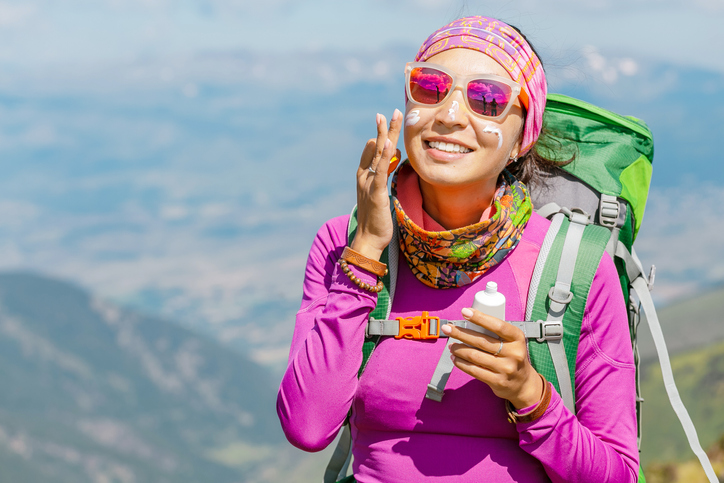Sunscreen is a cream, lotion, gel, or spray that absorbs or reflects UV rays from the sun. Sunscreens traditionally have blocked UVB rays thought to be most harmful to the skin. Current knowledge exists that UVA rays are also harmful to the skin. Newer sunscreens now absorb UVA and UVB rays. These are referred to as "broad spectrum" and are the preferred sunscreen to use. Sunscreens are safe for individuals over 6 months of age.
Regardless of your racial background, skin color, tanning ability, or age, it is recommended that everyone wear sunscreen. Because transplant recipients are at increased risk of developing skin cancer, it is especially important that you wear sunscreen.

It protects your skin from the damaging effects of the sun that lead to skin cancer. It will also prevent severe photoaging caused by the sun.

It should be applied every day if you are going to be in the sun for 15 minutes or more. It is best to apply the sunscreen 30 minutes prior to sun exposure, even during winter months in northern climates and on over-cast days in any climate.
There are many sunscreens to choose from. The American Academy of Dermatology recommends using a sunscreen with a SPF (sun protection factor) of 30 or greater. The reason for this recommendation is the following: Most persons apply 20%-50% of the amount of sunscreen needed to achieve the SPF rating of the applied product. When manufacturers give their product an SPF number, they are applying ~1-2 fluid ounces (30-60mls) to cover the entire body. This is much more than many individuals actually apply. When less is applied the SPF number goes down, and the individual is getting less protection than they may think.
Use a sunscreen that protects against UVA and UVB rays. "Broad-spectrum" is often listed on the sunscreen product, but it is important not to be misled by these labels and check that it truly blocks UVA and UVB rays.
Sunblocks known as "physical" and/or "mineral" sunscreens have zinc oxide and/or titanium dioxde in the active ingredient list. They work as soon as they are applied. Individuals with sensitive skin (including people with eczema) may experience less irritation from these sunscreens.
Sunscreens known as "chemical" sunscreens have other active ingredients, such as oxybenzone, octinoxate, and more. These chemical sunscreens start working about 20 minutes after they are applied.
Many people wear daily moisturizer and makeup. It is recommended that the daily moisturizer and/or makeup used have an SPF of 30 or greater. This allows for everyday protection in a manner that is effortless because it doesn't change the daily routine.
For those who dislike applying creams to their face and the rest of their skin surface, gel and spray sunscreens may be more acceptable. Oil-free daily moisturizers with SPF 30 are very lightweight and easily used as an after-shave type product.
Sunscreens that are oil-free are generally preferred by transplant recipients as they often encounter problems with acne. This is especially important for any sunscreen that is applied to the face.
Sunscreens that come in a stick or spray are often more acceptable for use around the eyes. A common complaint with sunscreen is burning of the eyes that can occur as a result of sweating. Stick and spray forms of sunscreen have been developed for use around the eyes to avoid this problem. Application of sunscreen 30 minutes prior to sun exposure and sweating also minimizes sunscreen running into the eyes as it has had time to truly dry.

SPF stands for Sun Protection Factor. The SPF value is the sunscreen's ability to block the UV rays from the sun. The SPF is calculated by comparing the dose of UV required to produce sunburn on skin protected by sunscreen compared with the dose of UV needed to produce sunburn on unprotected skin.

For example, skin protected by a sunscreen with an SPF of 10, requires 10 times the dose of UV to give a sunburn, compared with unprotected skin. The dose of UV is not simply time-dependent, meaning that this does not equate with a sunscreen with an SPF of 10 allowing one to be exposed to UV 10 times longer prior to developing a sunburn than if the skin wasn't protected with that sunscreen.
A sunscreen with an SPF of 30 blocks 97% of the sun burning rays. Higher number SPFs block slightly more of the sun’s rays, however, no sunscreen can block 100% of the sun’s burning rays. It is important to remember that 1-2 fluid ounces (30-60mls) are to be applied to attain the SPF number that the manufacturer labels the sunscreen. If less than that is applied, the SPF that the sunscreen is actually providing decreases, so patients at high risk for skin cancer may consider starting with a higher SPF.
No. Wearing protective clothing, a broad-brimmed hat, and avoiding the mid-day sun are also recommended.